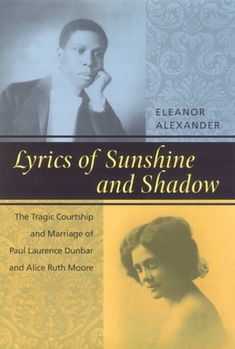Lyrics of Sunshine and Shadow: The Tragic Courtship and Marriage of Paul Laurence Dunbar and Alice Ruth Moore
Select Format
Select Condition 
Book Overview
A New York Times Notable Book of 2002
Format:Hardcover
Language:English
ISBN:0814706967
ISBN13:9780814706961
Release Date:July 2002
Publisher:New York University Press
Length:241 Pages
Weight:1.15 lbs.
Dimensions:0.9" x 6.3" x 9.3"
Customer Reviews
1 rating
Excellent Analysis
Published by Thriftbooks.com User , 19 years ago
I think that this book was excellent in that it provides a foundation for finding new ways to analyze history, seeing as how the history we are generally taught excludes people who were not members of mainstream society. A history that only focuses on mainstream society does not represent all of society and almost behaves as if other people did not exist or play major roles. Eleanor Alexander acknowledged that while there was not much documentation on the courtship and relations of the African American middle class, she was trying to start from the limited sources that were available to provide a new perspective. In addition, this novel touched upon some very real issues that are known but underplayed, including the racism and self-hatred that was very prevalent among black people and the fact that the patriarchal society was the primary basis for sexism that degraded the value of women. Dr. Alexander never once claimed that her ideas were facts, but she provided valid reasons to support her claims. For example, she explained the fact that Alice's history is undocumented but she allowed room for the possibility that Alice may have unofficially told of her own history in her short stories. She also presented proof in Alice's own words that Alice disliked darker-skinned blacks and that Paul, a dark-skinned black who exhibited self-hatred because of his color, disliked yet desired light-skinned women, the closest to the American definition of beauty, a white woman. Alexander posed questions that would make the reader think "Was this a possible factor?" If she was critical in her analysis, her criticism was matched by objectivity. In a way, learning negative truths about someone as famous as Paul Laurence Dunbar or his wife is unpleasing, but I appreciate her honesty. Another magnificent thing about this book is its analysis of gender relations and some of the practices that still exist today. The past does shape the present, and an excellent example she used was of rape and how society attributed more blame to the woman, as if the woman somehow did something to deserve it, and that is still a widespread problem today. Therefore, this book demonstrates how essential it is that we are provided with an encompassing presentation of history that allows us to see how many problems arose in the past and why they are still perpetuated today. The ideas that she presents in her novel are accompanied by documented primary sources that urge us to consider at the very least the possible validity of her claims. It is possible that some may say that she touched upon certain areas but then failed to explore further, but it is important to keep in mind that she stated repeatedly that there was limited documentation and that she was merely trying to provide new possibilies that would stir more people to follow her lead and delve deeper.





